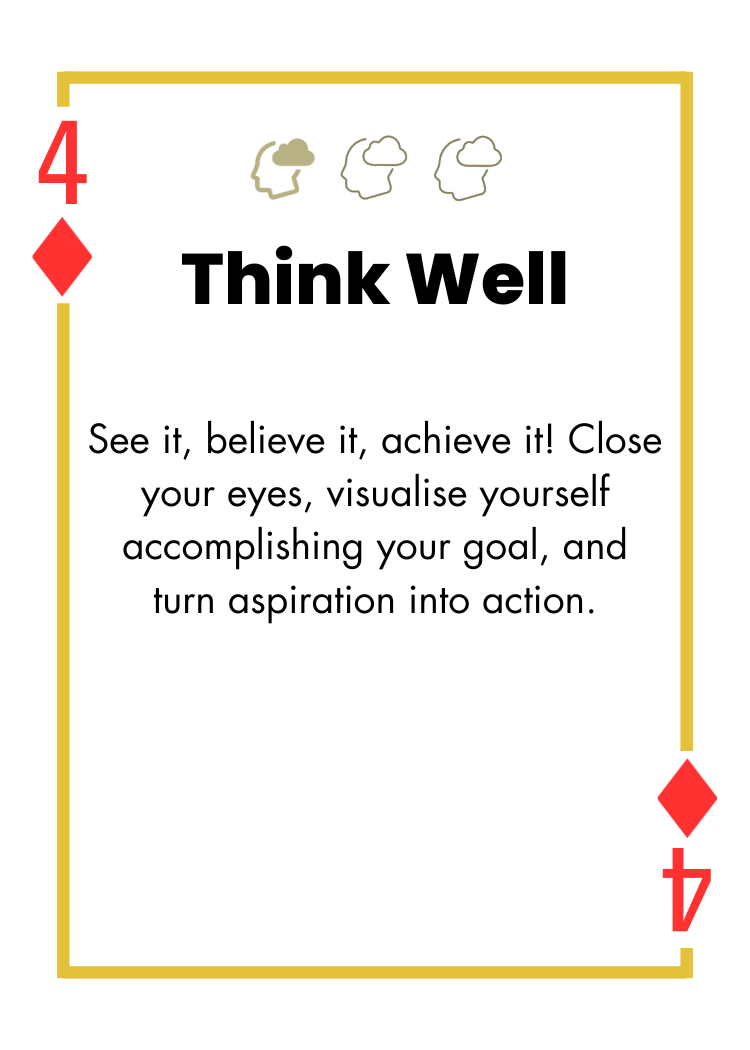4 of Diamonds - Visualisation

Visualisation, as a technique, is defined as the creation of mental images, or the formulation of a story, and can act as a system to access the imagination by involving a range of the senses. Visualisation creates bridges between the mind, body, and spirit and uses the mind to get in touch with the inner self. Visualisation is also known as guided imagery, centering, focus in amongst distraction, or meditation (Hoffart et al., 1998).

An excellent way to create a clear, real-life-like image in one’s mind is to involve all the senses including sight, (muscle) movement, touch, sound, smell, and taste. Visualisation is then a sensory experience occurring in the absence of usual external stimuli. By actively performing visualisation or imagery, individuals (athletes) create or recreate a life-like experience in their mind. Visualising any skill is like genuinely performing the skill, except instead of physically performing the skill, an individual only experiences the skill in their mind by picturing the performance of the skill (Jose et al., 2018).
Anyone may use the technique of visualisation to create positive images in their mind to influence real-life outcomes and achieve success. Specifically for athletes, the use of visualisation or imagery is a supplement to physical practice. Visualisation can also be used as a substitute for physical practice when athletes are not able to effectively practice physical skills when conditions prevent physical practice. Imagery intervention is shown to be beneficial for both the psychological and performance of athletes (Jose et al., 2018).
In one study looking at participants who visualised their weight training demonstrated greater strength gain and proficiency in their regimen. Based on the study data, the optimal visualisation duration is within a 5–15-minute range and produced approximately a 4.5kg increase in overall lift weight. In summary, this study demonstrated positive visualisation promotes a greater increase in physical performance versus groups which do not positively visualise (Hynes and Turner, 2020).
Visual imagery and thus performance are improved by harnessing the creative quadrant of the brain (Predoiu et al., 2020). Furthermore, visualisation involves accessing an altered state of consciousness whereby an individual’s biochemistry and brain waves modify and then become able to benefit from faster healing and performance (Naparstek, 2000).
https://www.healthjourneys.com/guided-imagery-101
Small changes CAN make a big difference. That’s what The 1% Club is all about.
Hoffart, M., Keene, E. and Pross M.S. (1998). The benefits of visualization: Research suggests that visualization promotes relaxation, enhances sleep, reduces pain, and increases creativity. American Journal of Nursing, 98(12), 44-47. Retrieved from http://ovidsp.ovid.com/ovidweb.cgi?T=JS&PAGE=reference&D=yrovftc&NEWS=N&AN=00000446-199898120-00025.
Hynes, J., & Turner, Z. (2020). Positive Visualization and Its Effects on Strength Training. Impulse (19343361).
Jose, J., Joseph, M. M., & Matha, M. (2018). Imagery: It’s effects and benefits on sports performance and psychological variables: A review study. International Journal of Physiology, Nutrition and Physical Education, 3(2), 190-193.
Krau, S. D. (2020). The multiple uses of guided imagery. Nursing Clinics, 55(4), 467-474.
Naparstek, B. (2000). What is guided imagery? https://www.healthjourneys.com/guided-imagery-101
Predoiu, R., Predoiu, A., Mitrache, G., Firanescu, M., Cosma, G., Dinuta, G., and Bucuroiu, R. A. (2020). Visualisation techniques in sport – The mental road map for success. Discobolul-Physical Education, Sport & Kinetotherapy Journal, 59(3).

 See Other Cards!
See Other Cards!